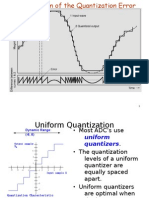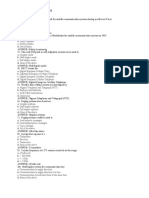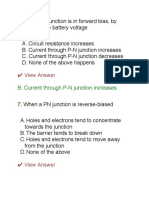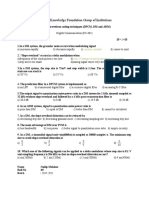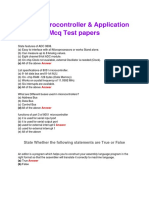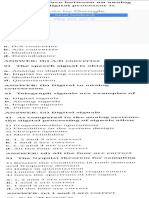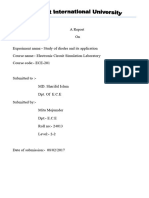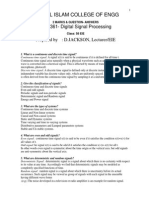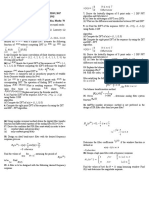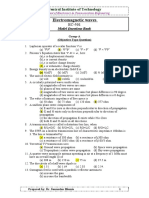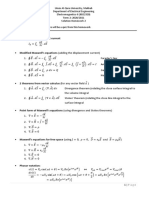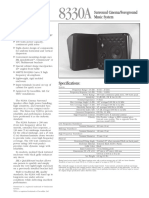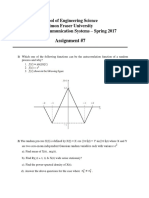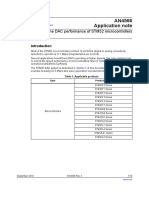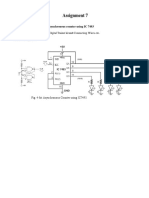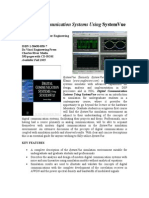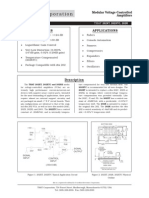Manuel S.
Enverga University Foundation
Lucena City, Philippines
Granted Autonomous Status
CHED CEB Res. 076-2009
Signal Spectra, Signal Processing
Midterm
Convolution
Sherwin C. Lagrama.,RECE,MMEM
College Of Engineering and Technical Department
1st Sem 2015-2016
COLLEGE OF ENGINEERING AND TECHNICAL DEPARTMENT
Telefax No. (042) 710-3151; e-mail:engg.dept_mseuf@yahoo.com.ph
�Digital Convolution
Digital convolution plays an important
role in digital filtering. As we verify in
the last section, a linear time-invariant
system can be represented by using
a digital convolution sum. Given a
linear time-invariant system, we can
Determine its unit-impulse response
h(n), which relates the system input
and output. To find the output
sequence y(n) for any input sequence
x(n), we write the digital convolution
as shown in Equation (15) as:
The sequences h(k) and x(k) in Equation (19)
are interchangeable. Hence, we
have an alternative form as
Example 10.
�contd Digital Convolution
Solution:
a. Since h(k) is defined, we plot it in Figure 18.
Next, we need to find the
reversed sequence h( k). We examine the
following for
k > 0, h( k) = 0
k = 0, h( 0) = h(0) = 3
k = 1, h( k) = h( ( 1)) = h(1) = 3
k = 2, h( k) = h( ( 2)) = h(2) = 1
k = 3, h( k) = h( ( 3)) = h(3) = 1
One can verify that k<= 4, h( k) = 0. Then
the reversed sequence
h( k) is shown as the second plot in Figure
18.
As shown in the sketches, h( k) is just a
mirror image of the original sequence h(k).
b. Based on the definition of the original
sequence, we know that
h(0) = h(1) = 3, h(2) = h(3) = 1, and the
others are zeros. The time indices
correspond to the following:
h(-k + 3) = h(0)=3, k = 3,
h(-k + 3) = h(1)=3, k = 2,
h(-k + 3) = h(2)=1, k = 1,
h(-k + 3) = h(3)=1, k = 0,
F IGURE 18 Plots of the digital sequence and its
reversed sequence in Example 10.
�contd Digital Convolution
F IGURE 19 Plot of the sequence h( -k + 3) in Example 10
Similarly, h( -k - 2) is yielded in Figure 20.
F IGURE 20 Plot of the sequence h( k 2) in Example 10
h(-k - 2) = h[-(-2)-2]=
h(-k - 2) = h[-(-3)-2]=
h(-k - 2) = h[-(-4)-2]=
h(-k - 2) = h[-(-5)-2]=
h(0)=3,
h(1)=3,
h(2)=1,
h(3)=1,
k = -2,
k = -3,
k = -4,
k = -5
Using the following sequences defined in
Figure 21, evaluate the digital convolution
TABLE 3 Digital convolution using the graphical
method.
Step 1. Obtain the reversed sequence h( -k).
Step 2. Shift h( -k) by [n] samples to get h(n
-k). If n=>0, h(- k) will be shifted to the right
by n samples; but if n < 0, h( - k) will be
shifted to the left by [n] samples.
Step 3. Perform the convolution sum that is
the sum of the products of two sequences
x(k) and h(n - k) to get y(n).
Step 4. Repeat steps 1 to 3 for the next
convolution value y(n).
a. By the graphical method.
b. By applying the formula directly.
4
�contd Digital Convolution
a. To obtain y(0), we need the reversed
sequence h( k); and to obtain y(1),
we need the reversed sequence h(1 - k),
and so on. Using the technique we
have discussed, sequences h( - k), h( -k +
1), h( - k + 2), h( - k + 3),
and h( -k + 4) are achieved and plotted in
Figure 22, respectively.
Again, using the information in Figures 21
and 22, we can compute the convolution
sum as:
sum of product of x(k) and h( -k): y(0) = 3 x
3=9
sum of product of x(k) and h(1 - k): y(1) = 1 x
3+3x2=9
sum of product of x(k) and h(2 - k): y(2) = 2 x
3 + 1 x 2 + 3 x 1 = 11
sum of product of x(k) and h(3 - k): y(3) = 2 x
2+1x 1=5
sum of product of x(k) and h(4 - k): y(4) = 2 x
1=2
sum of product of x(k) and h(5 - k): y(n) = 0
for n > 4, since sequences x(k) and h(n - k)
do not overlap.
Finally, we sketch the output sequence y(n) in
Figure 23.
b. Applying Equation (3.20) with zero initial
conditions leads to
y(n) = x(0)h(n) + x(1)h(n - 1) + x(2)h(n - 2)
F IGURE 21 Plots of digital input sequence and impulse sequence in Example 11.
Graphical Method
5
�By applying
formula
F IGURE 22 Illustration of convolution
of two sequences x(k) and h(k) in
Example
11.
F IGURE 23 Plot of the convolution sum in Example 11
�By Table method
�3.15 Using the following sequence definitions,
evaluate the digital convolution
a. using the graphical method;
b. using the table method;
c. applying the convolution formula directly.
3.16 Using the sequence definitions
Evaluate the digital convolution
a. using the graphical method;
b. using the table method;
c. applying the convolution formula directly.
3.17 Convolve the following two rectangular sequences:
Using the table method.
Library/Internet Research: Digital Convolution
(Minimum 10 pages, arial 11, margins 1s, single, use
MSEUF template) to be submitted on Sept. 20, 2015
�Thank you
Instructional materials by
Engr. SCLagrama.,RECE,MMEM
11
